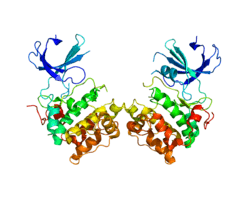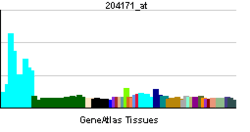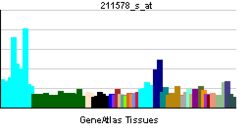P70-S6 Kinase 1
Ribosomal protein S6 kinase beta-1 is an enzyme that in humans is encoded by the RPS6KB1 gene.[1][2]
Function
This gene encodes a member of the RSK (ribosomal s6 kinase) family of serine/threonine kinases. This kinase phosphorylates several residues of the S6 ribosomal protein. The kinase activity of this protein leads to an increase in protein synthesis and cell proliferation.
Clinical significance
Inhibition of the S6K1 protein, or a lack of it, slows the production of adipose (fat) cells by disrupting and retarding the initial "commitment stage" of their formation. The study could have implications for the treatment of obesity.[3]
Amplification of the region of DNA encoding this gene and overexpression of this kinase are seen in some breast cancer cell lines.
Another pathway for which P70 has proposed involvement is in muscle lengthening and growing. P70 is phosphorylated by passive stretch in the soleus muscle. This may be one of many protein kinases involved in muscle building.[4]
Interactions
P70-S6 Kinase 1 has been shown to interact with:
See also
- Ribosomal S6 kinase
- P70S6 kinase
- RPS6KA1
References
- ↑ Grove JR, Banerjee P, Balasubramanyam A, Coffer PJ, Price DJ, Avruch J, Woodgett JR (1991). "Cloning and expression of two human p70 S6 kinase polypeptides differing only at their amino termini". Mol Cell Biol 11 (11): 5541–50. PMC 361924. PMID 1922062.
- ↑ "Entrez Gene: RPS6KB1 ribosomal protein S6 kinase, 70kDa, polypeptide 1".
- ↑ Carnevalli, L; NCarnevalli LS, Masuda K, Frigerio F, Le Bacquer O, Um SH, Gandin V, Topisirovic I, Sonenberg N, Thomas G, Kozma SC (2010). "S6K1 Plays a Critical Role in Early Adipocyte Differentiation". Dev Cell 18 (5): 763–74. doi:10.1016/j.devcel.2010.02.018. PMC 2918254. PMID 20493810.
- ↑ Van Dyke JM, Bain JL, Riley DA (April 2013). "Stretch activated signaling is modulated by stretch magnitude and contraction". Muscle Nerve 49 (1): 98–107. doi:10.1002/mus.23880. PMID 23620271.
- ↑ Nemazanyy I, Panasyuk G, Zhyvoloup A, Panayotou G, Gout IT, Filonenko V (2004). "Specific interaction between S6K1 and CoA synthase: a potential link between the mTOR/S6K pathway, CoA biosynthesis and energy metabolism". FEBS Lett. 578 (3): 357–62. doi:10.1016/j.febslet.2004.10.091. PMID 15589845.
- ↑ Panasyuk G, Nemazanyy I, Zhyvoloup A, Bretner M, Litchfield DW, Filonenko V, Gout IT (2006). "Nuclear export of S6K1 II is regulated by protein kinase CK2 phosphorylation at Ser-17". J. Biol. Chem. 281 (42): 31188–201. doi:10.1074/jbc.M602618200. PMID 16895915.
- ↑ Holz MK, Ballif BA, Gygi SP, Blenis J (2005). "mTOR and S6K1 mediate assembly of the translation preinitiation complex through dynamic protein interchange and ordered phosphorylation events". Cell 123 (4): 569–80. doi:10.1016/j.cell.2005.10.024. PMID 16286006.
- ↑ Ali SM, Sabatini DM (2005). "Structure of S6 kinase 1 determines whether raptor-mTOR or rictor-mTOR phosphorylates its hydrophobic motif site". J. Biol. Chem. 280 (20): 19445–8. doi:10.1074/jbc.C500125200. PMID 15809305.
- ↑ Ha SH, Kim DH, Kim IS, Kim JH, Lee MN, Lee HJ, Kim JH, Jang SK, Suh PG, Ryu SH (2006). "PLD2 forms a functional complex with mTOR/raptor to transduce mitogenic signals". Cell. Signal. 18 (12): 2283–91. doi:10.1016/j.cellsig.2006.05.021. PMID 16837165.
- ↑ Hara K, Maruki Y, Long X, Yoshino K, Oshiro N, Hidayat S, Tokunaga C, Avruch J, Yonezawa K (2002). "Raptor, a binding partner of target of rapamycin (TOR), mediates TOR action". Cell 110 (2): 177–89. doi:10.1016/S0092-8674(02)00833-4. PMID 12150926.
- ↑ Nojima H, Tokunaga C, Eguchi S, Oshiro N, Hidayat S, Yoshino K, Hara K, Tanaka N, Avruch J, Yonezawa K (2003). "The mammalian target of rapamycin (mTOR) partner, raptor, binds the mTOR substrates p70 S6 kinase and 4E-BP1 through their TOR signaling (TOS) motif". J. Biol. Chem. 278 (18): 15461–4. doi:10.1074/jbc.C200665200. PMID 12604610.
- ↑ Chiang GG, Abraham RT (2005). "Phosphorylation of mammalian target of rapamycin (mTOR) at Ser-2448 is mediated by p70S6 kinase". J. Biol. Chem. 280 (27): 25485–90. doi:10.1074/jbc.M501707200. PMID 15899889.
- ↑ Holz MK, Blenis J (2005). "Identification of S6 kinase 1 as a novel mammalian target of rapamycin (mTOR)-phosphorylating kinase". J. Biol. Chem. 280 (28): 26089–93. doi:10.1074/jbc.M504045200. PMID 15905173.
- ↑ Isotani S, Hara K, Tokunaga C, Inoue H, Avruch J, Yonezawa K (1999). "Immunopurified mammalian target of rapamycin phosphorylates and activates p70 S6 kinase alpha in vitro". J. Biol. Chem. 274 (48): 34493–8. doi:10.1074/jbc.274.48.34493. PMID 10567431.
- ↑ Long X, Lin Y, Ortiz-Vega S, Yonezawa K, Avruch J (2005). "Rheb binds and regulates the mTOR kinase". Curr. Biol. 15 (8): 702–13. doi:10.1016/j.cub.2005.02.053. PMID 15854902.
- ↑ Toral-Barza L, Zhang WG, Lamison C, Larocque J, Gibbons J, Yu K (2005). "Characterization of the cloned full-length and a truncated human target of rapamycin: activity, specificity, and enzyme inhibition as studied by a high capacity assay". Biochem. Biophys. Res. Commun. 332 (1): 304–10. doi:10.1016/j.bbrc.2005.04.117. PMID 15896331.
- ↑ Saitoh M, Pullen N, Brennan P, Cantrell D, Dennis PB, Thomas G (2002). "Regulation of an activated S6 kinase 1 variant reveals a novel mammalian target of rapamycin phosphorylation site". J. Biol. Chem. 277 (22): 20104–12. doi:10.1074/jbc.M201745200. PMID 11914378.
- ↑ Kim DH, Sarbassov DD, Ali SM, King JE, Latek RR, Erdjument-Bromage H, Tempst P, Sabatini DM (2002). "mTOR interacts with raptor to form a nutrient-sensitive complex that signals to the cell growth machinery". Cell 110 (2): 163–75. doi:10.1016/S0092-8674(02)00808-5. PMID 12150925.
- ↑ Edinger AL, Linardic CM, Chiang GG, Thompson CB, Abraham RT (2003). "Differential effects of rapamycin on mammalian target of rapamycin signaling functions in mammalian cells". Cancer Res. 63 (23): 8451–60. PMID 14679009.
- ↑ Leone M, Crowell KJ, Chen J, Jung D, Chiang GG, Sareth S, Abraham RT, Pellecchia M (2006). "The FRB domain of mTOR: NMR solution structure and inhibitor design". Biochemistry 45 (34): 10294–302. doi:10.1021/bi060976+. PMID 16922504.
- ↑ Takahashi T, Hara K, Inoue H, Kawa Y, Tokunaga C, Hidayat S, Yoshino K, Kuroda Y, Yonezawa K (2000). "Carboxyl-terminal region conserved among phosphoinositide-kinase-related kinases is indispensable for mTOR function in vivo and in vitro". Genes Cells 5 (9): 765–75. doi:10.1046/j.1365-2443.2000.00365.x. PMID 10971657.
- ↑ Burnett PE, Barrow RK, Cohen NA, Snyder SH, Sabatini DM (1998). "RAFT1 phosphorylation of the translational regulators p70 S6 kinase and 4E-BP1". Proc. Natl. Acad. Sci. U.S.A. 95 (4): 1432–7. doi:10.1073/pnas.95.4.1432. PMC 19032. PMID 9465032.
- ↑ Sarbassov DD, Sabatini DM (2005). "Redox regulation of the nutrient-sensitive raptor-mTOR pathway and complex". J. Biol. Chem. 280 (47): 39505–9. doi:10.1074/jbc.M506096200. PMID 16183647.
- ↑ Richardson CJ, Bröenstrup M, Fingar DC, Jülich K, Ballif BA, Gygi S, Blenis J (2004). "SKAR is a specific target of S6 kinase 1 in cell growth control". Curr. Biol. 14 (17): 1540–9. doi:10.1016/j.cub.2004.08.061. PMID 15341740.
- ↑ Peterson RT, Desai BN, Hardwick JS, Schreiber SL (1999). "Protein phosphatase 2A interacts with the 70-kDa S6 kinase and is activated by inhibition of FKBP12-rapamycinassociated protein". Proc. Natl. Acad. Sci. U.S.A. 96 (8): 4438–42. doi:10.1073/pnas.96.8.4438. PMC 16350. PMID 10200280.
- ↑ Bishop JD, Nien WL, Dauphinee SM, Too CK (2006). "Prolactin activates mammalian target-of-rapamycin through phosphatidylinositol 3-kinase and stimulates phosphorylation of p70S6K and 4E-binding protein-1 in lymphoma cells". J. Endocrinol. 190 (2): 307–12. doi:10.1677/joe.1.06368. PMID 16899564.
- ↑ 27.0 27.1 Panasyuk G, Nemazanyy I, Filonenko V, Gout I (2008). "Ribosomal protein S6 kinase 1 interacts with and is ubiquitinated by ubiquitin ligase ROC1". Biochem. Biophys. Res. Commun. 369 (2): 339–43. doi:10.1016/j.bbrc.2008.02.016. PMID 18279656.
| |||||||||||||||||||||||||||||||||||||||||||||||||||||||||||||||||||||||||||||||||||||||||||||||||||||||||||||||||||||||||||||||||||||||||||||||||||||||||||||||||


